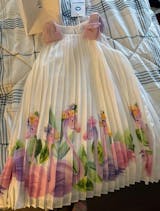We always buy Deux Par Deux brand because the quality is incredible! The zipper are durable, the material is thick and resilient against the cold, and their products hold up with my active boys putting them to the test. The print on this snowsuit was exactly what we were looking for. My puppy-loving son absolutely adores it!
The shipping was fast and it arrived well packaged!
Such a good sleeper! happy to support Canadian brands and my daughter sleeps so well in Petit Lem They have the cutest prints and best quality
We have this dress in green and I absolutely love it. I’ve been watching this for quite some time and I’m so glad I bought it. It’s stunning and versatile. And you can never go wrong with Mayoral. So pleased with my purchase. And I would definitely order from Jenni Kidz again.
Amazing quality, pockets and the button on the rear heel the stops the boys from destroying the heel of the suit. I have 3 boys and they all have the same one . Worth every penny !
Quality is excellent, 100% satisfied. Baby Rosalie thanks you for making her carriage rides happy warm adventures.
This dress is super cute and well made. It is a Christmas gift and I am anxious to see our sweetheart in it. Delivery from JENNI was very prompt. Thank You
We found Jenni Kidz so helpful because we were ordering from overseas and had a few questions, and they were so responsive and arranged gift wrap. Communication and delivery were great. The new parents loved the gift and especially the animals golf print and two way zip! Fantastic service!
Great communication. Assisted me with a return due to my error. Timely refund.
What a stunning dress. Happy I chose one size up as I find mayoral runs a little small. Gorgeous material and print. So flowy and perfect dress for a little wedding guest. Matches my dress perfectly.



























